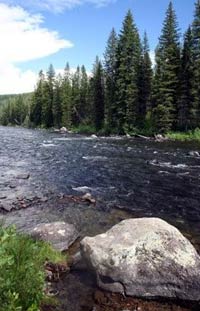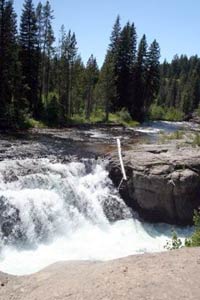Getting
Out There: |
Directory of all "Getting Out There" Articles> |
Sheep Falls on the Falls River
by Dennis Weaver
| When Dennis Weaver saw the new sign, his heart sank: "Sheep Falls-4 Miles." His favorite picnic spot, one of the most scenic places in eastern Idaho, had been discovered. Would the road be thronged with SUVs? Would the falls be crowded with campers and picnickers? Dennis headed down the little dirt track with trepidation, and came back with this report. |
|
Continued from Page 1
The river
At the bottom of the hill, the road breaks suddenly upon the river. It's a beautiful river, clear and shallow, churning through the rocks. It's a big river for such a high altitude-four car lanes wide-not a little creek like you usually find in the mountains. The river bends back and forth through the trees in gentle arcs, and the road follows it as it slips downstream to the falls. There are some spectacular primitive camping sites along the river; only the old fire rings and logs set out for benches tell you that others have camped there before you.
When we reached the river, we realized that we had seen no vehicles on the way in. Nor had we seen any campers or trucks along the road, even though it was a Saturday. So much for the crowds that concerned us.
We parked our SUVs on a giant rock platform 20 feet from the edge of the falls. The roar of the water shocked our ears as we stepped from the vehicles. It was still early enough in the day that a gentle breeze drifted up the canyon, and mist from the falls hung on the breeze making it lightly damp and refreshing in the July sun. We held little Lily's hand tightly as we walked to the edge of the cliff to look down on the falls.
At the falls, the river forks. Two-thirds of the river flows to the right toward where we stood; it then slips across a giant deck of a rock, and then falls over a ledge into a mass of roaring foam. For two years, there has been a weathered pine snag lodged in the rocks on the brink of the falls. The other third of the river slips across the hard rock deck to fall off another 50 yards downstream.
We watched the water for a while, enchanted by the motion, the power, the depth and the swirling pools. We talked about coming in on snow machines in the winter so that we could see the falls encrusted in ice. After a while, we slipped through a crevice in the hard rock deck that leads down to the river. A giant boulder is lodged in this crevice and we got down on hands and knees and crawled under it to a ledge that runs along the water's edge. In the perpetual moistness, the grass and tiny shrubs clinging on the ledge are a verdant green. We walked along the ledge, wading in water a few inches deep, until we could reach out and touch the falls. The intimacy and beauty awed us even though we had been there often. After a while, we climbed back up the crevice.
In the shade of a couple of gnarled trees at the top of the rock deck, Merri Ann and I sat with Lily and the baby and watched Debbie maneuver to take pictures. We were hungry and as soon as Debbie was through with her camera, we piled back in the cars and headed up the road. A quarter-mile above the falls, we drove through a patch of pines to the edge of the river and an old fire ring. We dug tinder from the bottom of a spruce and picked up wrist-sized sticks and soon had a fire going. Later in the summer, when the grasses were completely dry, the Forest Service imposed fire restrictions here, but now we enjoyed the fire. Lily roasted marshmallows and we roasted brats.
Ben and I pulled folding chairs to the top of the bank and watched the water, talking quietly. We wondered how many fish there were in this stretch, guessing that there were not many clinging to a living in the rushing water. Along the edge of the river, stonefly cases clung to the rocks, most of them belonging to golden stoneflies not the giant black ones that you find down in the valley. When we stepped to the river's edge, we saw an adult stonefly clinging to rock, the last of the season's hatch. I carefully picked it from the rock and flung it into the river. It floated about 10 feet and then a silver flash lashed across the current and grabbed the floating bug-so fast that it was startling. It seems fish were hiding in that rushing water after all.
We talked about the time, the year before, when we hiked down the ridge and dropped down into the canyon a mile or so below the falls. That time we were serious about fishing, carrying all the gear. Here we found a transformed river with beautiful pools flowing tightly against chalky, sand-colored cliffs. The canyon was still and quiet. On small dry flies, we caught eager trout-none over 12 inches-until we tired of it. We switched to nymphs, twisted lead onto our leaders, and pounded the bottom looking for bigger trout. We found none but there were 15-inch whitefish in the deep water, heavy enough to give a more substantial battle. We released all the fish.
Now the shadows were getting long and we loaded our gear back into the vehicles. On the way out, we would watch for deer along the edges, hoping they would come to browse in the cooler evening air. Our vehicles whined as they climbed slowly out of the canyon. There is one spot where we usually spin out against the rocks and this time was no different. Again, we dropped back, gave a little gas to build momentum, and climbed over the rocks. Soon we were out of the canyon.
Yes, we did see some deer on the way out. And yes, we were pleased that there were no crowds.
This is our favorite picnic spot. Please respect the wilderness. Don't litter and don't drive your vehicle off established trails. Make sure your fires are dead out, drenched in water until there is not a hint of remaining heat.
This is bear country. You are on the edge of one of the most remote wilderness areas left in the contiguous United States. Grizzlies wander from Yellowstone National Park through the adjacent Jedediah Smith Wilderness Area and into Teton National Park. Keep coolers and food in the vehicles where the bears can't get to them. Be alert and don't surprise them and they will be unlikely to bother you.
The drive from Ashton to the falls will take you about an hour. Take the second road to the left after crossing the plank bridge. Don't try driving down into the canyon without a four-wheel-drive vehicle with clearance equal to a Nissan Xterra. If you don't have a suitable vehicle, park and hike that last mile and a half.
Enjoy the falls. Just leave it as you found it.
The
Caribou-Targhee National Forest
Dennis Weaver
9/23/07


